Transporting or moving chickens.

Transporting chickens should be done in proper poultry crates or carriers. Single or small numbers of birds can be moved in cardboard boxes or dog cages. Cover the bottom of the crate with an inch or two of bedding material and keep them well ventilated and out of full sunshine. The best time of day to move chickens is early in the morning, they will be easy to catch while still in the coop or on the perches and the weather is generally cooler in the mornings.
How to transport chickens:
As a breeder over the last few years I have delivered thousands of chickens. Some locally and some quite far away.
The secret to keeping chickens calm and safe when transporting them is to have just enough space that they cant flap around and injure themselves. Chicken crates are designed do the birds cant stand up and are forced to lie down. It keeps them more calm.
Below: The standard chicken crate.
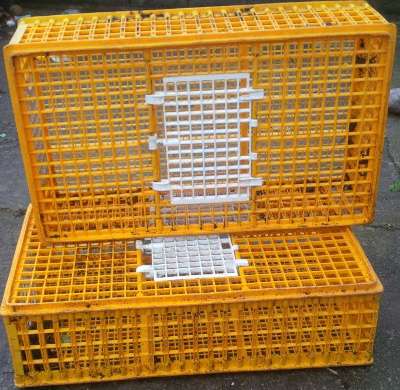
Know where your line in the sand is when it comes to transporting chickens, and book a speciality courier instead.
Problems to avoid when moving chickens:
- Prevent overheating. Getting too hot will kill chickens very quickly.
- Stop them escaping. Just imagine the chaos of trying to catch a wayward hen on a freeway or even a neighbourhood street.
- Avoid overcrowding. Chickens can suffocate each other in just a few minutes by piling and squashing the other birds in the carrier.
- Bad or freezing weather. Don't transport uncovered chickens in windy or wet conditions or if they may get frostbite.
- Avoid flock stress. A bad experience moving chickens can lead to illness, loss of egg production and bad behaviours.
How to move chickens by car:
Make sure the new coop and run is secure and ready for your flock.
Pack them quickly in their crates and move them as swiftly as possible to the new site.
The only special rule for transporting roosters and cockerels is too never put two or more in the same crate or box. Moving is stressful and even two males that get along happily in the backyard may injure each other in the crate and there is no escape.
Chickens tend to go into a Zen like state in low light conditions or darkness so excluding light may help you keep them calm.
Collecting chickens:
Taking care and doing a little planning makes sure that your new chickens first experiences with their new keepers is a good one. Make sure you know what diet they have been on so you can continue it for a while even if you plan to change it. Also use the same bedding for recently moved chickens as they are used to and maybe even bring some of their old bedding with them.
Below: Single use flat pack pet carriers.
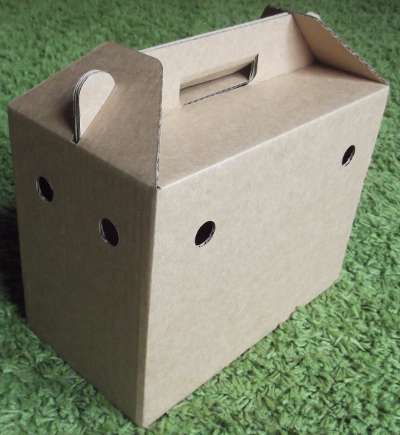
Fetching your new chickens is normally an easy task. People rarely buy chickens from far away and if they do then they choose next day delivery by specialist courier.
Making sure that the new coop and run is ready will save hassle as well and don't forget to keep them in for at least three days so as they customise to their new home before letting them onto pasture to range.
Take enough containers or boxes with you.
Below: Approved single use bird transport cardboard boxes.
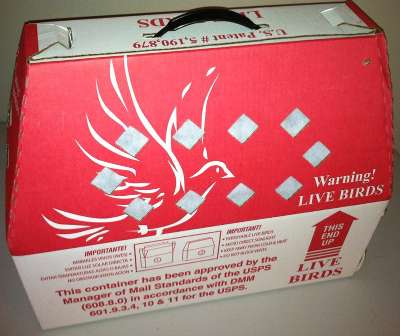
Plan a route to avoid traffic jams and stop start city driving if you can. Have the windows open enough to provide fresh air but not to ruffle the feathers. Or just use air conditioning to keep the air cool.
Avoid loud locations, shouting, smelly places and country roads with many potholes. I have added as much as 6 inches of straw to a poultry crate when moving young chickens or bantams.
Please don't be tempted to use bags or sacks or to wrap chickens up in towels, cloth or newspaper and duck tape. This is all things I have seen suggested on the internet but most are cruel and illegal.
Moving chicks and baby chickens:
Day old chicks are commonly sent in the post. As long as they are warm enough day old chicks can survive for 72 hours with no problems at all.
Below: Young chicks are transported overnight by post.

Transporting chicks can be done in a plastic tote that has been modified with a mesh cover and a mobile source of heat.
You can buy heat pads, hand warmers or use a hot water bottle or bag of warm sand. Heat pads can keep chicks warm for up to eight hours and a hot water bottle or bag of hot sand for up to 90 minutes.
You will need to keep the car windows closed or almost completely closed and use the heater if it's a cold day.
I have also moved very young chicks under their broody mum and it was one of the easiest things I have ever done. I used a dog crate with a few inches of shavings in the bottom and she sat tight like a limpet for the 90 minutes of the journey.
Transporting young Chickens:
Transporting young growers can be more problematic, They tend to panic more easily and do not fill the space in a chicken crate like bigger birds would. They are also more likely to pile into the corners and smother each other.
If you are using a crate to move young birds then put more bedding in the bottom to fill up the crate a bit so as they still can't stand and flap. Add a stiff card divider to split the crate into two halves and up the number of young birds you put in the crate.
How big are poultry crates?
The average poultry crate is 12 inches or 1 foot deep, 3 foot wide and 4 foot long. Turkey crates are the same size but half as deep again, so 18 inches deep for turkey crates. Home-made boxes and chicken crates need to 8 inches wide, 12 inches deep, and 10 inches tall per bird.
How many chickens fit in a crate?
The minimum cage and crate dimensions are 8 inches wide, 12 inches deep, and 10 inches tall per bird, that gives you an absolute maximum of 12 birds to a standard poultry crate. Less in warm weather or long moves.
Below: Minimum 30 cm or 12 inches depth for a poultry crate.
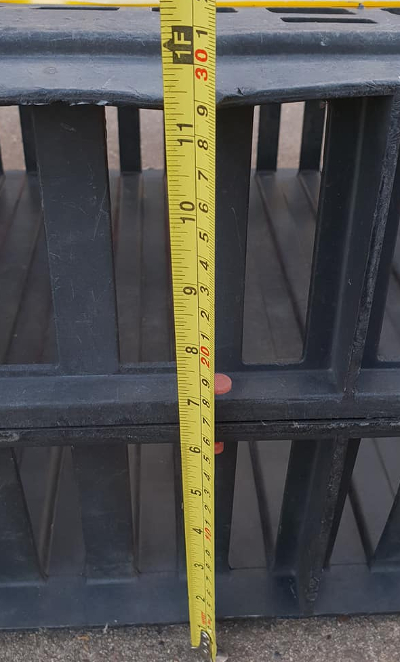
Poultry fit for transport should be carefully loaded into clean cages or crates. Load chickens one at a time and let them settle in the crate before you add another.
Can stress from transportation kill chickens?
Moving chickens around can kill very easily and quite quickly if the pile into each other and cram themselves into the corners of a cage.
How to reduce stress while transporting chickens:
- Combat Heat Stress by keeping the sun off the birds.
- First and foremost, make sure your flock has access to clean, cool water immediately before and straight after moving. This is crucial!
- Supplement with some ACV or Apple Cider Vinegar, electrolytes and some treats to take their mind off the move.
- Provide protection from the weather and wind.
- Don't crowd your flock or try to carry too many in the crates.
- Move during the cooler times of the day, preferably in the morning.
- Don't handle them roughly and try to keep your birds calm.
Do chickens need food and water while being moved?
Not when you are actually driving, the water will spill and the food will just waste. Chickens should be off their feet and settled on their bellies when actually moving.
If you are transporting chickens long distances then book in stop time when they can be fed and watered.
Many countries have laws about how long you can keep animals confined while in transit so check yours out before you leave.
I have driven with chickens in the car for 6 hours before and they were just fine in their crates. It was an English autumn so the weather was cool and the sun low in the sky. They had food and water before we left and there was a little grumpiness on arrival but nothing major. Any longer than this and I would plan a feed and water stop half way through.
Can you take chickens across state lines?
If you are moving to another state with chickens you will need to do some planning. If you can not get NPIP, then a vet's certification to carry chickens across the state lines would be fine as a one time deal.
Taking chickens to poultry shows:
Taking chickens to poultry shows normally involves specially built cages that keep the birds dark and single. This protects the feathers and the appearance of the bird.
Show chickens are used to travelling, it is part of their and the chickens keepers training for showing a bird.
Below: Custom made chicken carriers at a poultry show. Notice all the ventilation holes.
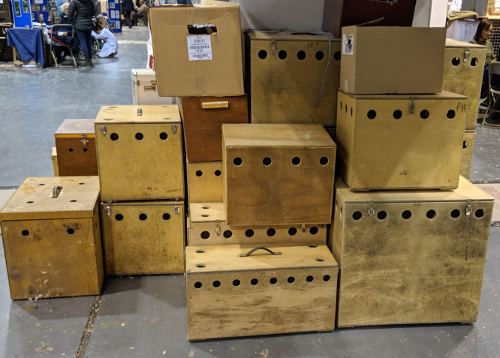
What types of containers are good for moving chickens?
Poultry transport crates: Chicken crates are designed to carry large amounts of chickens in a van/lorry not for a few pets in a car.
Cat carriers: A cat carrier will hold two chickens or three bantams or four true bantams. Cat carriers makes a good transport box for a couple of hens.
Dog Carriers: Another good form of transportation, but do put something over the top and three sides as the Cat Basket. It helps shade them and keep them calm. A dog carrier can take 4 to six hens depending on its size.
Cardboard Boxes: Make sure they are strong sturdy double walled card and cut plenty of half inch diameter holes. Also cardboard doesn't always have handles and is an excellent insulator so the birds can overheat really easily if the is not enough ventilation. On a hot summers day this could be very dangerous, so ensure there is ample ventilation all round, thus causing through draughts.
Card boxes have the advantage of being cheap or free, easy to get hold of and easy to dispose of when you are done. If you are just moving hens once then a cardboard box is ideal just make some holes in it!
2 crates zip tied or tie wrapped together: Get two crates like the ones your shopping is delivered in and tie wrap them together. Depending on the size they could take 2 or 4 birds per crate.
